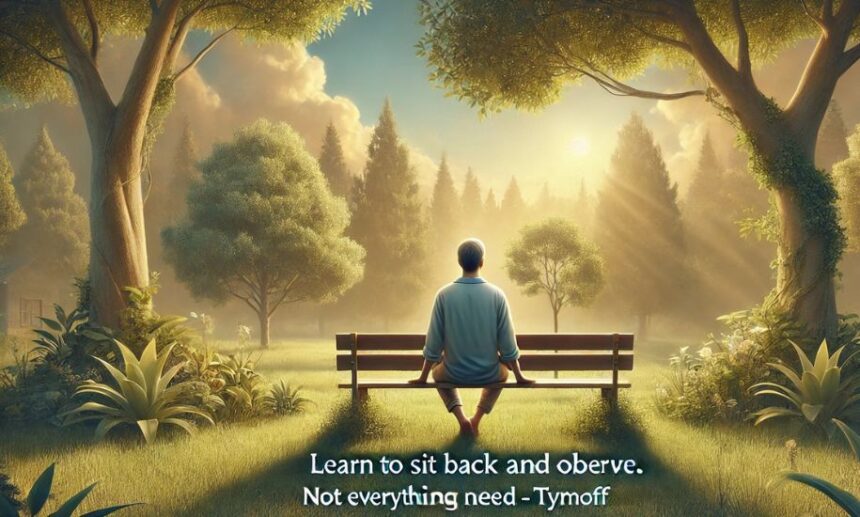In today’s fast-paced world, it is easy to get caught up in the whirlwind of activities and decisions that demand our attention. The idea of constantly reacting to everything happening around us can be overwhelming. But sometimes, the best action is no action at all. Learning to sit back and observe without feeling the need to intervene is a skill that requires patience and mindfulness. This philosophy is beautifully encapsulated in the saying “learn to sit back and observe. not everything need – tymoff,” which reminds us to practice discernment and restraint in our actions. In this article, we will explore what it truly means to step back, why it’s important, and how you can implement this philosophy into your everyday life.
What Does “Learn to Sit Back and Observe” Mean?
At its core, “learn to sit back and observe. not everything need – tymoff” encourages us to pause and observe the situations around us without immediately reacting. It suggests that not every problem or event requires our input or solution. This concept is rooted in mindfulness, a practice that emphasizes being fully present in the moment. When we observe without jumping to conclusions or actions, we give ourselves time to process situations more fully. By observing, we often realize that many problems resolve themselves without our intervention. This can lead to less stress and better decision-making.
For instance, in relationships or at work, there may be situations that evoke strong emotions, urging us to react quickly. But by choosing to sit back and watch the situation unfold, we may notice patterns, gain new insights, and ultimately make more informed decisions.
The Power of Patience
Incorporating the “learn to sit back and observe. not everything need – tymoff” mindset requires cultivating patience. Patience helps us become more self-aware, allowing us to make decisions based on reason rather than impulse. Patience also allows us to give others the space to express themselves fully, without rushing to impose our viewpoints.
This principle is especially relevant in a world where instant gratification is often the norm. When we practice patience and observation, we learn that not every moment needs to be filled with action. Sometimes, the best approach is to allow things to unfold naturally. This can apply to personal growth, relationships, or even professional challenges. By stepping back, we offer ourselves the chance to see the bigger picture, which often leads to a deeper understanding.
Embracing Mindfulness: Being Present Without Reaction
One of the key aspects of “learn to sit back and observe. not everything need – tymoff” is mindfulness. Mindfulness teaches us to be present in the moment, fully aware of our thoughts and surroundings. It encourages us to observe our thoughts and feelings without becoming attached to them or feeling the need to act on them immediately.
By practicing mindfulness, we become better equipped to deal with stress, anxiety, and conflict. Instead of reacting impulsively, we can choose to reflect, understand, and respond thoughtfully. Mindfulness can be practiced through meditation, deep breathing exercises, or simply taking time throughout the day to pause and reflect.
Incorporating mindfulness into your daily routine can help you embrace the philosophy of sitting back and observing. It allows you to remain calm in the face of challenges and resist the urge to control or change everything around you.
Applying “Learn to Sit Back and Observe” in Relationships
Relationships can often be a breeding ground for hasty reactions. Whether it’s with a friend, partner, or family member, emotional situations tend to spark impulsive responses. However, the philosophy of “learn to sit back and observe. not everything need – tymoff” can dramatically improve how we handle relationships.
When disagreements arise, rather than jumping into the conversation with your own opinions or defense, try sitting back and truly listening. Observing the other person’s feelings, thoughts, and perspectives without immediately reacting allows for a more constructive and empathetic conversation. By stepping back, you give the other person the space to express themselves fully, and in doing so, you build a stronger connection based on understanding and respect.
Similarly, in professional environments, adopting this practice can help you manage conflicts and build better relationships with colleagues. Sometimes, not everything needs an immediate response, especially when emotions are high. Sitting back and observing the situation can lead to more thoughtful and effective communication.
Finding Balance Between Action and Observation
While the philosophy of “learn to sit back and observe. not everything need – tymoff” emphasizes patience and reflection, it does not advocate for inaction in every situation. The key is finding a balance between observation and knowing when action is necessary. There are times when stepping in is required—whether it’s standing up for yourself or others, solving a pressing issue, or seizing an opportunity.
The important lesson here is that not everything requires immediate intervention. By learning to differentiate between situations that need your action and those that do not, you conserve your energy for what truly matters. This selective engagement allows you to be more intentional and focused in your life, reducing unnecessary stress.
How to Practice “Learn to Sit Back and Observe” Daily
Incorporating the “learn to sit back and observe. not everything need – tymoff” philosophy into your daily routine doesn’t have to be difficult. Here are some practical steps you can take:
- Pause Before Reacting: When faced with a situation, take a few moments to pause. This simple act of pausing can prevent impulsive reactions and give you the time to assess the situation more objectively.
- Practice Mindfulness: Dedicate time each day to practice mindfulness. Whether it’s through meditation or simply being more aware of your surroundings, mindfulness helps you stay grounded in the present moment.
- Observe Your Emotions: Instead of immediately reacting to emotions, try observing them. What are they telling you? Are they based on reality, or are they fleeting feelings that will pass? This introspective approach can help you manage your emotional responses more effectively.
- Reflect at the End of the Day: Take time at the end of each day to reflect on moments where you chose to sit back and observe. How did it benefit you? What did you learn from those situations? Reflecting on your daily experiences will reinforce this habit over time.
Conclusion
In a world that often glorifies constant action and quick reactions, the concept of “learn to sit back and observe. not everything need – tymoff” is a refreshing reminder to slow down and allow life to unfold naturally. By practicing patience, mindfulness, and discernment, you can navigate through life with more clarity, peace, and purpose. Remember, not everything needs your immediate action or involvement. Sometimes, the most profound growth comes from simply observing.





